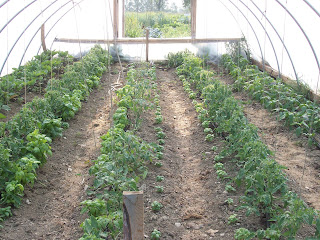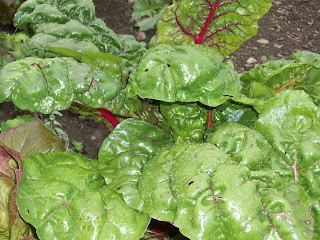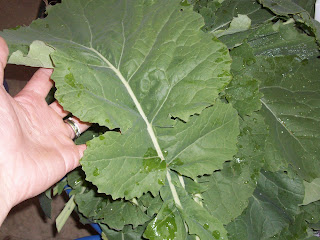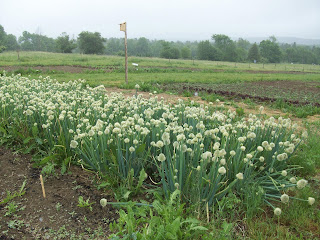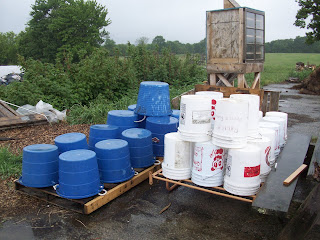The picture at the header of the blog is one that includes the radishes in your share today. I planted a mix this spring and I'm very, very pleased with how it came out. That is with the exception of the Black Spanish Radish which hardly germinated and didn't grow well when it did. I won't be growing that again but the others are all winners. You can find White Icicle, Pink Beauty, Crunchy Royale (red), and Plum (purple). All delicious, all great in salads or as a snack. I once tried to make horseradish dip by subbing radish for the horse radish. It tastes good but doesn't last very long so if you try that (find a recipe online) just make small batches and eat it fresh.
Next is the shallots. These are from last summer's garden and have been in our root cellar all winter. Shallots are amazing keepers and I could have kept them longer (into July and some say September before they sprout) but we're just plain out of room in the milk house on harvest day. A good problem to have. Shallots (this variety is Saffron Gold) are an excellent substitute for onions in any recipe. You just need to learn how much to sub. as a shallot bulb is several cloves like garlic and an onion is one bulb. If your recipe calls for cups you can use the same amount. Otherwise you'll have to experiment.
 Also this week we got the first of the spring scallions out of the garden to make room for other things. This are just like the ones you've already had except they were planted in Feb. of this year and not wintered over. Therefore they are young, tender and don't need to be cleaned up so much. Enjoy in salads, eggs or as an onion addition to a meal. I usually cut them up and put them into a skillet with hot oil before making a stir-fry. Also consider adding them to steamed greens with a little salt and pepper after sauteing them in olive oil or butter. Delicious.
Also this week we got the first of the spring scallions out of the garden to make room for other things. This are just like the ones you've already had except they were planted in Feb. of this year and not wintered over. Therefore they are young, tender and don't need to be cleaned up so much. Enjoy in salads, eggs or as an onion addition to a meal. I usually cut them up and put them into a skillet with hot oil before making a stir-fry. Also consider adding them to steamed greens with a little salt and pepper after sauteing them in olive oil or butter. Delicious. Also this week you will find another round of carrots (in with your radishes) and some more garlic scapes. Remember that scapes are the seed stalk from the garlic bulb. If you've never grown garlic it's good to know in case you want to. You have to remove the scape as soon as it emerges because the plant has only enough energy to put into one thing. We want that energy to go into making large, uniform, tasty bulbs of garlic below the ground. The scapes are a waste of energy to us. However, they do make a nice garlic addition to our summer meals when the root cellar garlic is gone and the new bulbs haven't matured yet.
Also this week you will find another round of carrots (in with your radishes) and some more garlic scapes. Remember that scapes are the seed stalk from the garlic bulb. If you've never grown garlic it's good to know in case you want to. You have to remove the scape as soon as it emerges because the plant has only enough energy to put into one thing. We want that energy to go into making large, uniform, tasty bulbs of garlic below the ground. The scapes are a waste of energy to us. However, they do make a nice garlic addition to our summer meals when the root cellar garlic is gone and the new bulbs haven't matured yet.  This week you will also find the first installment of beet greens (and beets). What can I say about beet greens? They are an old-time favorite. Lightly steamed with some salt, pepper and butter...delicious. My mouth is watering already. Just be sure to clean them well or you'll have gritty beet greens...yuck. That can ruin a good meal. One method is to 'float' them. Fill your sink with a bit of cold water and float the beet greens in there. Dunk them under with your hands a few times, etc. Then remove the greens. You'll see all the garden soil left behind. Just wash it down the sink. You may wish to do this a couple of times. I usually just rinse them off under the faucet because I count on the beneficial bacteria found in garden soil and on plants. Some people are sticklers for no soil on their beet greens though. To each his/her own.
This week you will also find the first installment of beet greens (and beets). What can I say about beet greens? They are an old-time favorite. Lightly steamed with some salt, pepper and butter...delicious. My mouth is watering already. Just be sure to clean them well or you'll have gritty beet greens...yuck. That can ruin a good meal. One method is to 'float' them. Fill your sink with a bit of cold water and float the beet greens in there. Dunk them under with your hands a few times, etc. Then remove the greens. You'll see all the garden soil left behind. Just wash it down the sink. You may wish to do this a couple of times. I usually just rinse them off under the faucet because I count on the beneficial bacteria found in garden soil and on plants. Some people are sticklers for no soil on their beet greens though. To each his/her own. The beets on some of your greens may be too large to cook in the short amount of time needed to steam the greens. Simply cut those off and cook them another way. One way is to roast them in the oven. Just don't let them dry out. Put a little water in the base of your roasting pot and check it throughout the cooking period. You can also just boil them.
Now, onto my favorite thing of the day. Basil! I love Basil. Emily and I (and Lizzie too) absolutely depend on pesto. We make several batches in the fall to freeze for winter. I recommend you just eat this up right away though. There will be another round later if you want to save it. First basil of the summer demands fresh eating though. Pesto recipes abound on the Internet. I got ours from a bargain 'Italian Cooking' book from Borders and it's served us well though now I just wing it and throw other things in too. (As an aside, if your kids don't like to eat spinach, kale, chard, etc. put it in the blender with your basil when you make pesto. I guarantee they eat it if they like pesto pasta.) There are multiple other things to do with basil and when we get tomatoes (when, not if hopefully) we can discuss one of my favorites. But for now I'll just include this link to our old blog where I've posted our pesto recipe. http://www.parkerproduce.org/csablog/id9.html
You will find two kinds of pesto in the bag. The large, light-green, frilly leaves are Napalatano (lettuce leaf basil) and the smaller, smoother, dark-green, glossy leaves are Genovese which is the standard basil found in stores. Both are quite good and offer different things to the cuisine. In the picture below the Napalatano is on the right and the Genovese is on the left.
 Finally, peas, peas and oh yes some peas please. Brittany and I have been picking peas all week and we can't stop now. They are coming in like crazy. Jim, the gentleman who comes to the farm to volunteer, loves to pick Sugar Snaps which are the trellised peas he helped plant. The vines are over 7 ft tall and producing like crazy. You have some different peas in your bag this week and I want to explain before someone takes a bite out of one that isn't an edible pod pea. That would ruin a day in a hurry. In the photo below we have a few examples of the different peas in your share. From left to right: Oregon Giant Snow Pea, Sugar Ann/Sugar Snap (interchangeable for your purposes), Coral/Strike/Caselode (also interchangeable). The last one is not an edible pod pea. You can only eat the peas themselves by breaking open the pod. If they make it to a pot of boiling water I'll be very surprised. We just eat them like a snack. Grab two bowls, fill one with pea pods out of your bag. Sit down with a good book and shuck the peas. Eat them. Put the empty pods into the empty bowl. Compost them when finished for a good source of nitrogen. Simple as that. If you do want to cook the peas feel free. They are still just as good cooked. I just can't usually wait that long. Some of the peas may be a bit past their prime. Just separate those ones and cook them. They just stayed in the field a day or two too long before we could get to them to harvest. Nothing wrong with them and cooking will soften them back up again.
Finally, peas, peas and oh yes some peas please. Brittany and I have been picking peas all week and we can't stop now. They are coming in like crazy. Jim, the gentleman who comes to the farm to volunteer, loves to pick Sugar Snaps which are the trellised peas he helped plant. The vines are over 7 ft tall and producing like crazy. You have some different peas in your bag this week and I want to explain before someone takes a bite out of one that isn't an edible pod pea. That would ruin a day in a hurry. In the photo below we have a few examples of the different peas in your share. From left to right: Oregon Giant Snow Pea, Sugar Ann/Sugar Snap (interchangeable for your purposes), Coral/Strike/Caselode (also interchangeable). The last one is not an edible pod pea. You can only eat the peas themselves by breaking open the pod. If they make it to a pot of boiling water I'll be very surprised. We just eat them like a snack. Grab two bowls, fill one with pea pods out of your bag. Sit down with a good book and shuck the peas. Eat them. Put the empty pods into the empty bowl. Compost them when finished for a good source of nitrogen. Simple as that. If you do want to cook the peas feel free. They are still just as good cooked. I just can't usually wait that long. Some of the peas may be a bit past their prime. Just separate those ones and cook them. They just stayed in the field a day or two too long before we could get to them to harvest. Nothing wrong with them and cooking will soften them back up again.Oregon Giant Snow Peas are excellent in stir-fry dishes. Think Asian food (Thai is my personal favorite). I will actually cook those in a stir-fry though they are quite good raw like the sugar snaps/sugar anns.
 Also in this week's share is the usual lettuce. There is so much coming out of the garden right now we didn't have time to bag it all. We had to compost some lettuce we harvested today. I don't like doing that but I am comforted by knowing that it will be recycled back into nutrients for the garden. You still get lettuce in your share this week in the form of an head of Nancy (the light green, full sized head) and Australe (the smaller, reddish green head). Enjoy!
Also in this week's share is the usual lettuce. There is so much coming out of the garden right now we didn't have time to bag it all. We had to compost some lettuce we harvested today. I don't like doing that but I am comforted by knowing that it will be recycled back into nutrients for the garden. You still get lettuce in your share this week in the form of an head of Nancy (the light green, full sized head) and Australe (the smaller, reddish green head). Enjoy!
 Also in this week's share is the usual lettuce. There is so much coming out of the garden right now we didn't have time to bag it all. We had to compost some lettuce we harvested today. I don't like doing that but I am comforted by knowing that it will be recycled back into nutrients for the garden. You still get lettuce in your share this week in the form of an head of Nancy (the light green, full sized head) and Australe (the smaller, reddish green head). Enjoy!
Also in this week's share is the usual lettuce. There is so much coming out of the garden right now we didn't have time to bag it all. We had to compost some lettuce we harvested today. I don't like doing that but I am comforted by knowing that it will be recycled back into nutrients for the garden. You still get lettuce in your share this week in the form of an head of Nancy (the light green, full sized head) and Australe (the smaller, reddish green head). Enjoy!Thank you to everyone who has submitted feedback regarding the share and your participation with Parker Produce. I appreciate it very much as it helps me make this a stronger local food chain. Have a good weekend.








